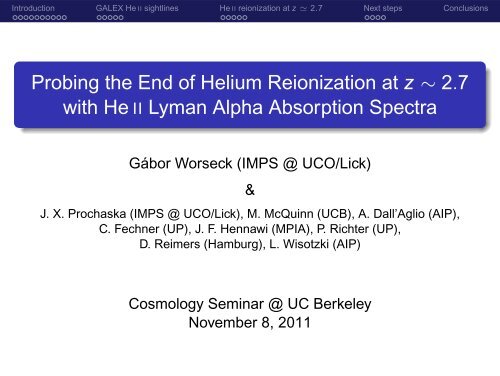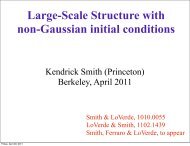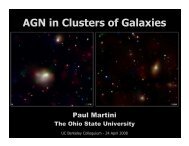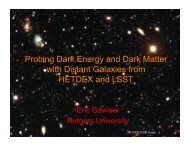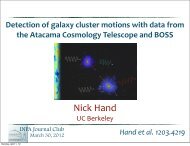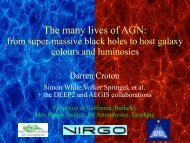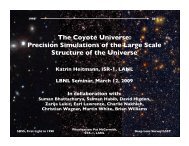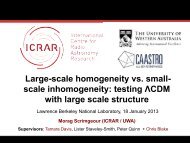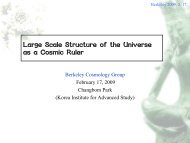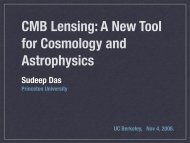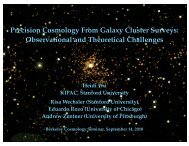Probing the End of HeII Reionization at z~2.7 with HeII Lyman Alpha ...
Probing the End of HeII Reionization at z~2.7 with HeII Lyman Alpha ...
Probing the End of HeII Reionization at z~2.7 with HeII Lyman Alpha ...
Create successful ePaper yourself
Turn your PDF publications into a flip-book with our unique Google optimized e-Paper software.
Introduction GALEX He II sightlines He II reioniz<strong>at</strong>ion <strong>at</strong> z≃ 2.7 Next steps Conclusions<br />
<strong>Probing</strong> <strong>the</strong> <strong>End</strong> <strong>of</strong> Helium <strong>Reioniz<strong>at</strong>ion</strong> <strong>at</strong> z ∼ 2.7<br />
<strong>with</strong> He II <strong>Lyman</strong> <strong>Alpha</strong> Absorption Spectra<br />
Gábor Worseck (IMPS @ UCO/Lick)<br />
&<br />
J. X. Prochaska (IMPS @ UCO/Lick), M. McQuinn (UCB), A. Dall’Aglio (AIP),<br />
C. Fechner (UP), J. F. Hennawi (MPIA), P. Richter (UP),<br />
D. Reimers (Hamburg), L. Wisotzki (AIP)<br />
Cosmology Seminar @ UC Berkeley<br />
November 8, 2011
Introduction GALEX He II sightlines He II reioniz<strong>at</strong>ion <strong>at</strong> z≃ 2.7 Next steps Conclusions<br />
Outline<br />
1 Introduction: The IGM and helium reioniz<strong>at</strong>ion<br />
2 Finding rare He II quasar sightlines <strong>with</strong> GALEX UV photometry<br />
3 New HST/COS He II sightlines: He II reioniz<strong>at</strong>ion ends <strong>at</strong> z ≃ 2.7<br />
4 Resolving <strong>the</strong> process <strong>of</strong> He II reioniz<strong>at</strong>ion<br />
5 Conclusions
Introduction GALEX He II sightlines He II reioniz<strong>at</strong>ion <strong>at</strong> z≃ 2.7 Next steps Conclusions<br />
A short history <strong>of</strong> <strong>the</strong> universe<br />
Cosmic Time<br />
(years)<br />
∼300,000<br />
∼500 million<br />
∼1 billion<br />
∼13 billion<br />
adapted from Djorgovski et al. & Digital Media Center, Caltech<br />
✛ The Big Bang<br />
The Universe filled <strong>with</strong> ionized gas<br />
✛ The Universe becomes neutral and opaque<br />
The Cosmic Dark Ages start<br />
Cosmic Dawn:<br />
First galaxies and quasars form,<br />
hydrogen reioniz<strong>at</strong>ion starts<br />
✛ Hydrogen reioniz<strong>at</strong>ion complete,<br />
<strong>the</strong> Universe becomes transparent again<br />
Tiny neutral hydrogen fraction<br />
in intergalactic space<br />
✛ Humans observe <strong>the</strong> Universe
Introduction GALEX He II sightlines He II reioniz<strong>at</strong>ion <strong>at</strong> z≃ 2.7 Next steps Conclusions<br />
The basics <strong>of</strong> IGM absorption<br />
credits: Andrew Pontzen
Introduction GALEX He II sightlines He II reioniz<strong>at</strong>ion <strong>at</strong> z≃ 2.7 Next steps Conclusions<br />
H I absorbers: Sinks & diffuse sources <strong>of</strong> UV radi<strong>at</strong>ion<br />
balance between photoioniz<strong>at</strong>ion and radi<strong>at</strong>ive recombin<strong>at</strong>ion<br />
frequency distribution <strong>of</strong> NHI values for IGM absorbers (’clouds’)<br />
log NHI < 14.5: optically thin Lyα forest<br />
log NHI > 20.3: optically thick damped systems<br />
17.2 < log NHI < 20.3:<br />
<strong>Lyman</strong> limit systems<br />
identified by <strong>Lyman</strong><br />
limit break (τ912 > 1),<br />
translucent <strong>at</strong> high<br />
energies<br />
14.5 < log NHI < 17.2:<br />
translucent near <strong>the</strong><br />
<strong>Lyman</strong> limit break<br />
log f(N HI, X)<br />
−10<br />
−15<br />
−20<br />
−25<br />
12 14 16 18 20 22<br />
log NHI Prochaska & Tumlinson (2009)
Introduction GALEX He II sightlines He II reioniz<strong>at</strong>ion <strong>at</strong> z≃ 2.7 Next steps Conclusions<br />
Sources <strong>of</strong> <strong>the</strong> UV background<br />
Star-forming galaxies<br />
high space density<br />
small escape fraction<br />
s<strong>of</strong>t UV radi<strong>at</strong>ion<br />
Quasars<br />
low space density<br />
short lifetime (∼ 10 Myr)<br />
hard UV radi<strong>at</strong>ion
Introduction GALEX He II sightlines He II reioniz<strong>at</strong>ion <strong>at</strong> z≃ 2.7 Next steps Conclusions<br />
Overview: Intergalactic helium<br />
after reioniz<strong>at</strong>ion: IGM <strong>of</strong> H and He in photoioniz<strong>at</strong>ion equilibrium<br />
<strong>with</strong> UV background<br />
He reioniz<strong>at</strong>ion likely two-step process:<br />
1 He I−→He II @ z ∼ 6 (hν > 24.6 eV required)<br />
2 He II−→He III @ z ∼ 3 (hν > 54.4 eV required)<br />
reason: hard UV photons only produced by quasars,<br />
full He reioniz<strong>at</strong>ion delayed until quasars sufficiently abundant<br />
Tracers <strong>of</strong> He II reioniz<strong>at</strong>ion:<br />
◮ indirect: IGM temper<strong>at</strong>ure, ioniz<strong>at</strong>ion st<strong>at</strong>e <strong>of</strong> IGM metals<br />
◮ direct: He II Lyα absorption <strong>at</strong> λrest = 303.78 Å<br />
(He II is hydrogenic ion)
Introduction GALEX He II sightlines He II reioniz<strong>at</strong>ion <strong>at</strong> z≃ 2.7 Next steps Conclusions<br />
Simul<strong>at</strong>ions: He III bubbles around quasars<br />
semi-analytic models and radi<strong>at</strong>ive transfer simul<strong>at</strong>ions<br />
prediction: inhomogeneous and extended He II reioniz<strong>at</strong>ion<br />
(∼ 1Gyr)<br />
0<br />
1<br />
0<br />
1<br />
McQuinn et al. (2009)<br />
<strong>HeII</strong>I Fraction<br />
Transmission
Introduction GALEX He II sightlines He II reioniz<strong>at</strong>ion <strong>at</strong> z≃ 2.7 Next steps Conclusions<br />
Constraining He II reioniz<strong>at</strong>ion requires large samples<br />
large sightline variance in He II absorption,<br />
no impact on H I forest<br />
reason: stochasticity <strong>of</strong> He II-ionizing quasars<br />
><br />
∼ 25 He II sightlines can distinguish simple reioniz<strong>at</strong>ion models<br />
1<br />
1<br />
0.5<br />
1<br />
transmission / x <strong>HeII</strong> 0.5<br />
0.5<br />
0<br />
3 3.02 3.04 3.06 3.08 3.1<br />
redshift<br />
probability per unit log mean transmission<br />
0.8<br />
0.7<br />
0.6<br />
0.5<br />
0.4<br />
0.3<br />
0.2<br />
0.1<br />
x <strong>HeII</strong>I = 0.99<br />
x <strong>HeII</strong>I = 0.94<br />
x <strong>HeII</strong>I = 0.85<br />
0<br />
0.001 0.01 0.1<br />
mean transmission<br />
McQuinn et al. (2009)
Introduction GALEX He II sightlines He II reioniz<strong>at</strong>ion <strong>at</strong> z≃ 2.7 Next steps Conclusions<br />
Problem I: Far UV −→ <strong>Lyman</strong> continuum absorption<br />
far UV transition −→ space<br />
Galactic <strong>Lyman</strong> limit restricts<br />
He II observ<strong>at</strong>ions to z > 2<br />
high-z <strong>Lyman</strong> limit systems<br />
−→ strong cumul<strong>at</strong>ive <strong>Lyman</strong><br />
continuum absorption<br />
< 10% <strong>of</strong> all sightlines<br />
transparent <strong>at</strong><br />
λrest = 304Å<br />
Worseck & Prochaska (2011)
Introduction GALEX He II sightlines He II reioniz<strong>at</strong>ion <strong>at</strong> z≃ 2.7 Next steps Conclusions<br />
Problem II: UV-bright quasars are rare!<br />
IGM absorption + QSO LF = number <strong>of</strong> UV-bright QSOs<br />
most UV-bright quasars <strong>at</strong> low redshifts for He II studies (zem < 3)<br />
HST sensitivity limit: z304 > ∼ 2.7<br />
prediction: ∼ 200 m304 < 21 He II quasars<br />
−→HST probes He II reion.!<br />
assumption: unbiased<br />
’3π’ quasar survey <strong>at</strong><br />
m1450 < 19<br />
Worseck & Prochaska (2011)
Introduction GALEX He II sightlines He II reioniz<strong>at</strong>ion <strong>at</strong> z≃ 2.7 Next steps Conclusions<br />
Few He II observ<strong>at</strong>ions to d<strong>at</strong>e −→ zreion ∼ 3<br />
only 5 sightlines studied <strong>at</strong> R > 800 (HST/STIS, FUSE)<br />
main fe<strong>at</strong>ures: Gunn-Peterson trough <strong>at</strong> z > 3,<br />
p<strong>at</strong>chy He II absorption <strong>at</strong> 2.7 < z < 3, forest <strong>at</strong> z < 2.7<br />
He III zones around background and foreground quasars<br />
Worseck & Wisotzki (2006)
Introduction GALEX He II sightlines He II reioniz<strong>at</strong>ion <strong>at</strong> z≃ 2.7 Next steps Conclusions<br />
Selection <strong>of</strong> UV-bright QSOs from GALEX photometry<br />
previous surveys were UV-blind<br />
GALEX: first UV all-sky survey <strong>at</strong><br />
mAB < ∼ 21<br />
two bands: NUV (1750–2200Å) and<br />
FUV (1350-1750Å)<br />
Follow-up <strong>of</strong> GALEX-detected high-z<br />
quasars<br />
NASA/JPL-Caltech
Introduction GALEX He II sightlines He II reioniz<strong>at</strong>ion <strong>at</strong> z≃ 2.7 Next steps Conclusions<br />
Our GALEX color selection technique<br />
NUV flux is not sufficient (low-z <strong>Lyman</strong> limit systems)<br />
significant FUV flux required (<strong>at</strong> least for zem < 3.5 QSOs)
Introduction GALEX He II sightlines He II reioniz<strong>at</strong>ion <strong>at</strong> z≃ 2.7 Next steps Conclusions<br />
GALEX finds <strong>the</strong> known needles in <strong>the</strong> haystack<br />
FUV dropout: opaque sightline, He II not observable<br />
known He II quasars have blue GALEX UV colors
Introduction GALEX He II sightlines He II reioniz<strong>at</strong>ion <strong>at</strong> z≃ 2.7 Next steps Conclusions<br />
SDSS quasar selection depends on <strong>the</strong> u − g color<br />
mock SDSS photometry<br />
processed <strong>with</strong> SDSS quasar<br />
target selection routine<br />
color-selected SDSS quasars<br />
have redder u − g colors than<br />
radio-selected quasars<br />
SDSS preferentially selects<br />
quasars <strong>with</strong> red u − g colors<br />
<strong>at</strong> 3 < zem < 3.6<br />
reason: red quasars are<br />
stellar locus outliers,<br />
blue quasars have colors<br />
similar to stars<br />
−→ lost in stellar locus<br />
Worseck & Prochaska (2011)
Introduction GALEX He II sightlines He II reioniz<strong>at</strong>ion <strong>at</strong> z≃ 2.7 Next steps Conclusions<br />
SDSS color bias −→ SDSS <strong>Lyman</strong> limit system bias<br />
red u − g colors<br />
primarily caused by<br />
IGM <strong>Lyman</strong> continuum<br />
absorption<br />
SDSS is <strong>Lyman</strong> break<br />
survey <strong>at</strong> 3 < zem < 3.6<br />
SDSS sightlines <strong>at</strong><br />
3 < zem < 3.6 have too<br />
many <strong>Lyman</strong> limit<br />
systems<br />
SDSS is inefficient in<br />
finding UV-bright<br />
quasars<br />
Worseck & Prochaska (2011)
Introduction GALEX He II sightlines He II reioniz<strong>at</strong>ion <strong>at</strong> z≃ 2.7 Next steps Conclusions<br />
Our successful HST/COS He II survey<br />
GALEX color selection: predicted success r<strong>at</strong>e ∼ 60%<br />
HST/COS FUV spectroscopy <strong>of</strong> 8 FUV-bright QSOs (21 orbits)<br />
UV-bright QSOs (mFUV < 21.5):<br />
simultaneous confirm<strong>at</strong>ion and follow-up<br />
6/8 sightlines transparent <strong>at</strong> He II edge
Introduction GALEX He II sightlines He II reioniz<strong>at</strong>ion <strong>at</strong> z≃ 2.7 Next steps Conclusions<br />
Fluctu<strong>at</strong>ing Gunn-Peterson troughs<br />
Ground: Hydrogen <strong>at</strong> z ∼ 6<br />
Fan et al. (2006)<br />
Far UV: Helium (He II) <strong>at</strong> z ∼ 3<br />
Worseck et al. (2011)
Introduction GALEX He II sightlines He II reioniz<strong>at</strong>ion <strong>at</strong> z≃ 2.7 Next steps Conclusions<br />
Fluctu<strong>at</strong>ing Gunn-Peterson troughs<br />
Ground: Hydrogen <strong>at</strong> z ∼ 6<br />
Fan et al. (2006)<br />
Far UV: Helium (He II) <strong>at</strong> z ∼ 3<br />
Worseck et al. (2011)
Introduction GALEX He II sightlines He II reioniz<strong>at</strong>ion <strong>at</strong> z≃ 2.7 Next steps Conclusions<br />
He II reioniz<strong>at</strong>ion ends <strong>at</strong> zreion ≃ 2.7<br />
Measurements: He II effective optical depth on ∼ 10 proper Mpc<br />
Worseck et al. (2011)
Introduction GALEX He II sightlines He II reioniz<strong>at</strong>ion <strong>at</strong> z≃ 2.7 Next steps Conclusions<br />
He II reioniz<strong>at</strong>ion ends <strong>at</strong> zreion ≃ 2.7<br />
Measurements: He II effective optical depth on ∼ 10 proper Mpc<br />
Worseck et al. (2011)
Introduction GALEX He II sightlines He II reioniz<strong>at</strong>ion <strong>at</strong> z≃ 2.7 Next steps Conclusions<br />
He II reioniz<strong>at</strong>ion ends <strong>at</strong> zreion ≃ 2.7<br />
Measurements: He II effective optical depth on ∼ 10 proper Mpc<br />
z < ∼ 2.7: agreement <strong>with</strong> semi-analytic model <strong>of</strong> photoionized IGM<br />
Worseck et al. (2011)
Introduction GALEX He II sightlines He II reioniz<strong>at</strong>ion <strong>at</strong> z≃ 2.7 Next steps Conclusions<br />
He II reioniz<strong>at</strong>ion ends <strong>at</strong> zreion ≃ 2.7<br />
Measurements: He II effective optical depth on ∼ 10 proper Mpc<br />
z < ∼ 2.7: agreement <strong>with</strong> semi-analytic model <strong>of</strong> photoionized IGM<br />
z > ∼ 2.7: large sc<strong>at</strong>ter in effective optical depth<br />
Our survey: 4× redshift p<strong>at</strong>hlength <strong>at</strong> 2.7 < z < 3<br />
Worseck et al. (2011)
Introduction GALEX He II sightlines He II reioniz<strong>at</strong>ion <strong>at</strong> z≃ 2.7 Next steps Conclusions<br />
He II reioniz<strong>at</strong>ion ends <strong>at</strong> zreion ≃ 2.7<br />
Measurements: He II effective optical depth on ∼ 10 proper Mpc<br />
z < ∼ 2.7: agreement <strong>with</strong> semi-analytic model <strong>of</strong> photoionized IGM<br />
z > ∼ 2.7: large sc<strong>at</strong>ter in effective optical depth<br />
Our survey: 4× redshift p<strong>at</strong>hlength <strong>at</strong> 2.7 < z < 3<br />
Numerical simul<strong>at</strong>ions (McQuinn et al. 2009):<br />
good m<strong>at</strong>ch to d<strong>at</strong>a for zreion ≃ 2.7, zreion > ∼ 3 ruled out<br />
Worseck et al. (2011)
Introduction GALEX He II sightlines He II reioniz<strong>at</strong>ion <strong>at</strong> z≃ 2.7 Next steps Conclusions<br />
Comparison H I and He II<br />
H I: complementary optical spectroscopy<br />
(Keck/HIRES and VLT/UVES)<br />
co-eval H I Lyα forest traces density field<br />
underdense regions constrain He II fraction (McQuinn 2009)<br />
He II/H I traces SED <strong>of</strong> ionizing radi<strong>at</strong>ion field<br />
Worseck et al. (2011)
Introduction GALEX He II sightlines He II reioniz<strong>at</strong>ion <strong>at</strong> z≃ 2.7 Next steps Conclusions<br />
The end stages <strong>of</strong> He II reioniz<strong>at</strong>ion<br />
H I breaks density degeneracy<br />
p<strong>at</strong>chy He II absorption due to<br />
different ioniz<strong>at</strong>ion conditions<br />
instead <strong>of</strong> density fluctu<strong>at</strong>ions<br />
simul<strong>at</strong>ions: H I and He II<br />
correl<strong>at</strong>ed in reionized regions<br />
end stages <strong>of</strong> He II reioniz<strong>at</strong>ion<br />
<strong>at</strong> 2.7 < z < 3<br />
Worseck et al. (2011)
Introduction GALEX He II sightlines He II reioniz<strong>at</strong>ion <strong>at</strong> z≃ 2.7 Next steps Conclusions<br />
A dedic<strong>at</strong>ed survey for He II-reionizing quasars<br />
<strong>Lyman</strong> break survey for<br />
faint (g < ∼ 24.5) quasars<br />
in <strong>the</strong> vicinity <strong>of</strong> He II<br />
sightlines<br />
goal: associ<strong>at</strong>e quasars<br />
<strong>with</strong> He II absorption<br />
fe<strong>at</strong>ures<br />
wide field (30 ′ ×30 ′ )<br />
deep u band imaging<br />
◮ LBC @ LBT<br />
◮ MOSAIC @ KPNO<br />
spectroscopic follow-up<br />
◮ VIMOS @ VLT<br />
◮ LRIS @ Keck
Introduction GALEX He II sightlines He II reioniz<strong>at</strong>ion <strong>at</strong> z≃ 2.7 Next steps Conclusions<br />
Goal: Constrain quasar lifetime and anisotropy<br />
He III zone or hard UV radi<strong>at</strong>ion near foreground quasar<br />
−→ light travel time gives lower limit on quasar lifetime<br />
current sample (3 quasars): 10–30 Myr<br />
Quasar light fronts in comoving space<br />
Worseck et al. (2007)
Introduction GALEX He II sightlines He II reioniz<strong>at</strong>ion <strong>at</strong> z≃ 2.7 Next steps Conclusions<br />
A dedic<strong>at</strong>ed multi-color survey for UV-bright quasars<br />
most GALEX-detected quasars too faint for HST<br />
SDSS selects against UV-bright quasars<br />
goal: find <strong>the</strong> missing quasars via <strong>the</strong>ir unusual SED
Introduction GALEX He II sightlines He II reioniz<strong>at</strong>ion <strong>at</strong> z≃ 2.7 Next steps Conclusions<br />
Intitial results: 22 UV-bright z > 2.7 quasars<br />
follow-up spectroscopy <strong>of</strong> promising SDSS+GALEX sources <strong>with</strong><br />
Lick/KAST and CAHA/CAFOS<br />
so far: 22 quasars (2.7 < z < 3.8) ready for HST/COS<br />
continu<strong>at</strong>ion in 2012
Introduction GALEX He II sightlines He II reioniz<strong>at</strong>ion <strong>at</strong> z≃ 2.7 Next steps Conclusions<br />
Shedding light on <strong>the</strong> 2nd epoch <strong>of</strong> reioniz<strong>at</strong>ion<br />
He II Lyα absorption probes He II reioniz<strong>at</strong>ion<br />
◮ Gunn-Peterson troughs −→ large He II fraction<br />
◮ Large sample variance predicted −→ large samples required<br />
Efficient He II target selection via GALEX photometry<br />
◮ Blue GALEX colors indic<strong>at</strong>e transparent sightlines<br />
◮ SDSS selects against UV-bright quasars<br />
HST/COS: Six new He II absorption spectra<br />
◮ 4× previous redshift p<strong>at</strong>hlength in He II absorption<br />
◮ Variance in He II absorption <strong>at</strong> z ∼ 2.9<br />
−→delayed and inhomogeneous He reioniz<strong>at</strong>ion<br />
◮ Comparison to simul<strong>at</strong>ions: He II reioniz<strong>at</strong>ion ended <strong>at</strong> z ≃ 2.7<br />
Resolving <strong>the</strong> process <strong>of</strong> He II reioniz<strong>at</strong>ion<br />
◮ New sample <strong>of</strong> UV-bright quasars missed by SDSS<br />
◮ Survey for foreground quasars to interpret He II absorption spectra<br />
◮ Unique constraints on quasar lifetime and anisotropy


